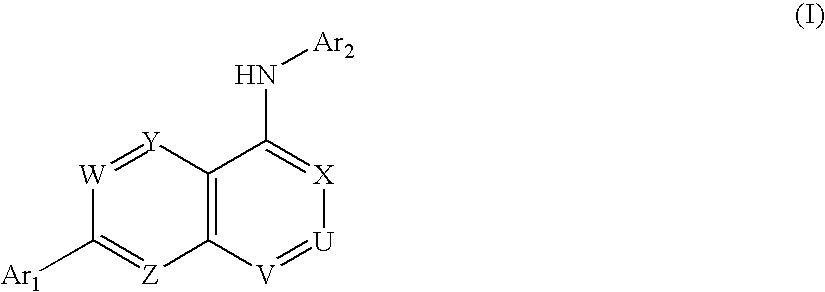Carboxylic acid, phosphate or phosphonate substituted quinazolin-4-ylamine analogues as capsaicin receptor modulators
a carboxylic acid, phosphate or phosphonate-substituted technology, applied in the field of acid-substituted quinazolin4ylamine analogues, can solve the problems of acute or chronic pain, more debilitating, and damage to the nervous system
- Summary
- Abstract
- Description
- Claims
- Application Information
AI Technical Summary
Problems solved by technology
Method used
Image
Examples
example 1
Preparation of Representative Compounds
[0317]This Example illustrates the preparation of representative acid-substituted quinazolin-4-ylamine analogues.
A. 3-[4-(4-trifluoromethyl-pheylamino)-7-(3-trifluoromethyl-pyridin-2-yl)-quinazolin-2-yl]-propionic acid
1. 2-p-tolyl-3-trifluoromethyl-pyridine
[0318]
[0319]To a de-gassed mixture of 2-chloro-3-(trifluoromethyl)-pyridine (70.1 mmol), p-tolylboronic acid (70.6 mmol), and 2M Na2CO3 (175.0 mmol) in DME (200 mL) under nitrogen, add Pd(PPh3)4 (2.8 mmol). Stir the mixture at 80° C. overnight, concentrate, and extract with EtOAc. Dry over Na2SO4, concentrate under vacuum, and pass through a silica gel pad to give 2-p-tolyl-3-trifluoromethyl-pyridine.
2. 2-(4-methyl-3-nitro-phenyl)-3-(trifluoromethyl)-pyridine
[0320]
[0321]To a solution of 2-p-tolyl-3-trifluoromethyl-pyridine (8.4 mmol) in H2SO4 (6 mL) cautiously add fuming HNO3 (2 ml). Stir the mixture for 60 minutes at room temperature. Pour the mixture onto ice-water (30 mL), extract with EtO...
example 2
Preparation of Representative Compounds
[0372]This Example illustrates the preparation of additional representative acid-substituted quinazolin-4-ylamine analogues.
A. 6-Amino-3′-chloro-[2,2′]bipyridinyl-5-carboxylic acid amide
1. 2-Acetyl-3-chloropyridine
[0373]
[0374]Dissolve 3-chloro-2-cyanopyridine (10.0 g, 0.072 mol; see Chem. Pharm. Bull. (1985) 33:565-571) in anhydrous THF (200 mL) under N2 atmosphere and cool in an ice bath. Add dropwise 3.0 M MeMgI in diethyl ether (48 ml, 0.14 mol) to the reaction mixture and stir in an ice bath for 2 hours. Pour the reaction mixture over ice cold water, acidify the mixture with 2.0 N aq. HCl to pH 2 to 3. Extract the reaction mixture with EtOAc (3×100 mL) and dry over anhydrous MgSO4. Filter, concentrate under vacuum and then filter through a pad of silica gel using 20% ethyl acetate / hexane as eluent. Removal of solvent under reduced pressure gives pure 2-acetyl-3-chloropyridine as an oil.
2. 1-(3-Chloro-pyridin-2-yl)-3-dimethylaminopropenone
[0...
example 3
Additional Representative Acid-Substituted Quinazolin-4-ylamine Analogues
[0411]Using routine modifications, the starting materials may be varied and additional steps employed to produce other compounds encompassed by the present invention. Compounds listed in Table II were prepared using the above methods, with readily apparent modifications. In the column labeled Ki in Table II, * indicates that the Ki determined as described in Example 5, herein, is 1 micromolar or less.
[0412]
TABLE IIRepresentative Acid-Substituted Quinazoline-4-ylamine AnaloguesCompoundNameMSKi1.3-[4-(4-Trifluoromethyl-phenylamino)-7-(3-trifluoromethyl-pyridin-2-yl)-quinazolin-2-yl]-propionic acid507.20*2.3-[7-(3-Trifluoromethyl-pyridin-2-yl)-4-(6-trifluoromethyl-pyridin-3 -ylamino)-quinazolin-2-yl]-propionicacid3.[4-(4-Trifluoromethyl-phenylamino)-7-(3-trifluoromethyl-pyridin-2-yl)-quinazolin-2-ylamino]-acetic acid508.21*4.4-(4-Trifluoromethyl-phenylamino)-7-(3-trifluoromethyl-pyridin-2-yl)-quinazoline-2-carboxy...
PUM
| Property | Measurement | Unit |
|---|---|---|
| temperatures | aaaaa | aaaaa |
| time | aaaaa | aaaaa |
| flow rate | aaaaa | aaaaa |
Abstract
Description
Claims
Application Information
 Login to View More
Login to View More - R&D
- Intellectual Property
- Life Sciences
- Materials
- Tech Scout
- Unparalleled Data Quality
- Higher Quality Content
- 60% Fewer Hallucinations
Browse by: Latest US Patents, China's latest patents, Technical Efficacy Thesaurus, Application Domain, Technology Topic, Popular Technical Reports.
© 2025 PatSnap. All rights reserved.Legal|Privacy policy|Modern Slavery Act Transparency Statement|Sitemap|About US| Contact US: help@patsnap.com



